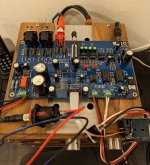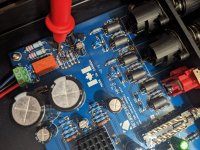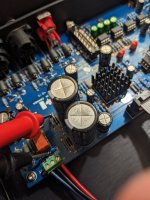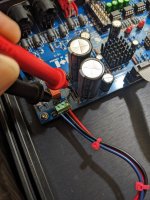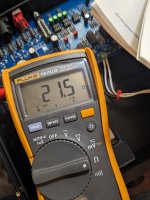Great Customer Service for an Excellent Product
Personally, I was looking for a headphone amp with very low noise characteristics that would pair well with my low noise Benchmark 3 DAC. Also, I wanted an amp that would be capable of easily driving my Hifiman He1000V2 cans. Therefore, I decided to try building Tom's kit. Unfortunately, I rushed into soldering the board and I was extremely rusty in my soldering techniques. In retrospect, I should have read some of Tom's excellent guides prior to starting the project.
After rushing through the build I struggled with noise issues and channel drop out when testing the board. Tom was very helpful and responsive in an attempt to help me get the board working properly. Eventually, Tom offered to personally analyze the board for a small fee so I shipped the board back to Tom. Very shortly thereafter, Tom discovered several issues with the board and proceeded to fix those issues. He turned around the board in a very short time frame and now I have a working amp that sounds great with my headphones. It is very quite and transparent sounding when paired with the Benchmark 3 DAC.
I'm very impressed with Tom's customer service as he was extremely helpful and responsive. In the end everything worked out. Just a note, for anyone considering building the board. Go for it and if you are rusty like me take the time to read Tom's guides to soldering, etc.!
Personally, I was looking for a headphone amp with very low noise characteristics that would pair well with my low noise Benchmark 3 DAC. Also, I wanted an amp that would be capable of easily driving my Hifiman He1000V2 cans. Therefore, I decided to try building Tom's kit. Unfortunately, I rushed into soldering the board and I was extremely rusty in my soldering techniques. In retrospect, I should have read some of Tom's excellent guides prior to starting the project.
After rushing through the build I struggled with noise issues and channel drop out when testing the board. Tom was very helpful and responsive in an attempt to help me get the board working properly. Eventually, Tom offered to personally analyze the board for a small fee so I shipped the board back to Tom. Very shortly thereafter, Tom discovered several issues with the board and proceeded to fix those issues. He turned around the board in a very short time frame and now I have a working amp that sounds great with my headphones. It is very quite and transparent sounding when paired with the Benchmark 3 DAC.
I'm very impressed with Tom's customer service as he was extremely helpful and responsive. In the end everything worked out. Just a note, for anyone considering building the board. Go for it and if you are rusty like me take the time to read Tom's guides to soldering, etc.!
Thank you for writing and sharing your experience. I appreciate it. I'm glad you like the amp.
As you discovered, SAC305 lead-free solder is awful to work with and results in solder joints that are grainy in appearance which makes it impossible to tell the good joints from the bad ones. If you're going the lead-free route I recommend spending the bit extra and getting AIM Sn100C or any of the other germanium or bismuth doped 99.3/0.7 Sn/Cu alloys out there.
Lead solder (60/40 Sn/Pb or 63/37 Sn/Pb) is still my favourite. I use it for prototypes and such. All my fully assembled boards are made with lead-free solder.
For those interested in the nitty-gritty details of solder alloys, I suggest they read here: https://neurochrome.com/pages/choosing-solder
Tom
As you discovered, SAC305 lead-free solder is awful to work with and results in solder joints that are grainy in appearance which makes it impossible to tell the good joints from the bad ones. If you're going the lead-free route I recommend spending the bit extra and getting AIM Sn100C or any of the other germanium or bismuth doped 99.3/0.7 Sn/Cu alloys out there.
Lead solder (60/40 Sn/Pb or 63/37 Sn/Pb) is still my favourite. I use it for prototypes and such. All my fully assembled boards are made with lead-free solder.
For those interested in the nitty-gritty details of solder alloys, I suggest they read here: https://neurochrome.com/pages/choosing-solder
Tom
Tom,
Based upon your advice, I recently purchased some AIM Sn100C to use on my next project.
I highly recommend your "choosing solder" guide, especially if it has been a long time since you have done any soldering. Also, it is better to read the choosing solder guide prior to soldering instead of afterwards🙂
Thanks again for your help and advice,
Alex
Based upon your advice, I recently purchased some AIM Sn100C to use on my next project.
I highly recommend your "choosing solder" guide, especially if it has been a long time since you have done any soldering. Also, it is better to read the choosing solder guide prior to soldering instead of afterwards🙂
Thanks again for your help and advice,
Alex
That page frequently bubbles to the top in the Google search results, actually. I had fun writing it. 🙂
You'll like the Sn100C. It behaves very similarly to 60/40 Sn/Pb, except for the higher melting point.
Tom
You'll like the Sn100C. It behaves very similarly to 60/40 Sn/Pb, except for the higher melting point.
Tom
After setting my HP-2 aside for the last year the gift of a Schiit Modius E this holiday with balanced outputs led me to see if I could figure out the issues I was having again. I decided to purchase the case Tom offers to give it a proper home to rule out any problems not having it housed could cause. Of course that is when I discovered that the caps I substituted since the specked ones were out of stock at the time are too tall to fit under the cover. So a couple standoffs under the top plate are now installed. After hooking everything up I still had this odd buzz through the headphones when the power switch was off. When I turned the amp on the buzz would disappear after the startup delay. I double checked everything but no change. I remembered that Tom had mentioned when trying to help me before that the issues I was having trying to use the HP-2 as a preamp could be power supply related. I was using the suggested 28v Meanwell unit so thought it unlikely but was at a loss so dug around my collection of old power supplies and found a 19v laptop unit and plugged it in. No buzz, looks like I got a bad power supply from Meanwell. So I ordered a new 28v Meanwell supply and the shorter caps from Mouser to hopefully get everything sorted.
Question, what is the impact of running the amp using a 19v supply instead of the 28v supply it is setup for?
The overall setup is a pi 4 NAS and streamer running MoOde, Schiit Modius E, the HP-2, and HD650 headphones. It now sounding very good.
Question, what is the impact of running the amp using a 19v supply instead of the 28v supply it is setup for?
The overall setup is a pi 4 NAS and streamer running MoOde, Schiit Modius E, the HP-2, and HD650 headphones. It now sounding very good.
With 19 V you'll get lower maximum output power. Not really an issue in most cases.
If you want to run the HP-2 on 19 V, I suggest you change R69:

Note that you can now find the full design documentation on the HP-2 product page.
Tom
If you want to run the HP-2 on 19 V, I suggest you change R69:
Note that you can now find the full design documentation on the HP-2 product page.
Tom
I found a couple 24v power supplies to try, both Meanwell. A GST120A24-P1M and a GST18A24-P1J. The GST120A24-P1M does not cause the buzz with the power switch off, the GST18A24-P1J does cause the buzz. So the 28v GST25A28-P1J and 24v GST18A24-P1J both buzz. Makes me less confident that the replacement GST24A28-P1J I ordered will not buzz as well but we will see when it shows up. Maybe Meanwell had some manufacturing issues a few years ago when I ordered these or could there be some other issue?
I'm curious what you mean by buzz. I mean... I know what buzzing is, but what is it that buzzes? Is it the power supply? The amp? Buzz in the headphones?
If the supply buzzes when the amp is off, it's probably unhappy about a light load which means that either Mean Well has changed the design or the GST24 has some sort of issue where it buzzes under light load and some other condition that I have yet to find.
XP Power is an alternative. Perhaps the ACM24US24 would work for you. It's a 24 V, 24 W supply. But let's try to sort out what exactly is buzzing and maybe work through a couple of ideas for fixes before throwing more money at power supplies.
Tom
If the supply buzzes when the amp is off, it's probably unhappy about a light load which means that either Mean Well has changed the design or the GST24 has some sort of issue where it buzzes under light load and some other condition that I have yet to find.
XP Power is an alternative. Perhaps the ACM24US24 would work for you. It's a 24 V, 24 W supply. But let's try to sort out what exactly is buzzing and maybe work through a couple of ideas for fixes before throwing more money at power supplies.
Tom
The buzz comes through the headphones when power is off. Power on after startup delay is silent when no music is playing.
That's really odd as the headphones are disconnected by a relay when the power is off. J2 connects to the headphones. So I guess it would be prudent to measure the voltage across D1 when the power is off and when it's on. The voltage there should be 0 V when the power is off and close to 24 V when it's on and the start-up delay has passed.

Tom
Tom
That's not measured across D1, though. Across means you hook one probe to one end of D1 and the other to the other end of D1. Personally I would put the plus probe on the cathode of D1 (which is also +24 V) and the minus on the anode of D1, but it really doesn't matter in this case as I'm only interested in the magnitude of the voltage.
Your measurement does answer one thing, though: The relay does not have power when the amp is turned off. That's as designed.
So now, I would measure the resistance from pin 3 to pin 4 of the relay with the power off. Do the same for the resistance from pin 5 to pin 6. Do this with the headphones disconnected.
The output side of the relay are easy to find as they're also available on C1, C2. The input side of the relay goes to the anode of D4 (connects to relay pin 3). Similarly the anode of D5 connects to relay pin 6.
Those resistance measurements should show near infinite resistance with the amp turned off and near zero resistance once the start-up delay has expired and the relay has engaged.
Tom
Your measurement does answer one thing, though: The relay does not have power when the amp is turned off. That's as designed.
So now, I would measure the resistance from pin 3 to pin 4 of the relay with the power off. Do the same for the resistance from pin 5 to pin 6. Do this with the headphones disconnected.
The output side of the relay are easy to find as they're also available on C1, C2. The input side of the relay goes to the anode of D4 (connects to relay pin 3). Similarly the anode of D5 connects to relay pin 6.
Those resistance measurements should show near infinite resistance with the amp turned off and near zero resistance once the start-up delay has expired and the relay has engaged.
Tom
Are you sure you're measuring on the side of C1, C2 that connect to the relay. I don't have the layout in front of me and won't be able to until about a week from now.
Come to think of it, instead of measuring on C1, C2, you can also measure from D4, D5 anode to pins 1, 3 on the output connector. Pin 1 on the connector is marked with a rectangular pad. Also see Appendix A-2 in the design doc.
Tom
Come to think of it, instead of measuring on C1, C2, you can also measure from D4, D5 anode to pins 1, 3 on the output connector. Pin 1 on the connector is marked with a rectangular pad. Also see Appendix A-2 in the design doc.
Tom
Nope not sure at all. Please excuse me but obviously I am not the most savvy when it comes to electronics but I think I got it now. Measuring from pin 1 and pin 3 on the output to the anode side of D4 and D5 it works as intended. Amp off infinite resistance, amp on near zero.
Out of curiosity I connected my meter between pin 2 and pin 1 of the output and measured AC. The specked 28V supply measured 2.1V with the amp off and 0.021V with the amp on. The quiet 24V supply measured 0.03V with the amp off and 0V with the amp on.
Out of curiosity I connected my meter between pin 2 and pin 1 of the output and measured AC. The specked 28V supply measured 2.1V with the amp off and 0.021V with the amp on. The quiet 24V supply measured 0.03V with the amp off and 0V with the amp on.
Cool. And then, finally, let's measure the resistance from pins 1,3 on the output connector to ground (pin 2). Do this with the amp off and headphones disconnected. You should see near infinite resistance.
Tom
Tom
Confirmed. Near infinite resistance between pin 1 or 3 and pin 2 with amp off and headphones disconnected.
That means the headphones are disconnected from the circuit when the power is off. That's exactly as designed. What you're dealing with is probably some sort of capacitive coupling from the power supply to the headphones. I'm guessing the buzz you hear is very faint.
You could try to connect a 2N7000 as follows: Gate and source connect to Q5 gate and source. Then take the drain through a resistor to the internal 24 V rail. You can pick that up on the cathode of D2. The resistor should be a few hundred ohm, maybe 1 kΩ. The value is not critical.
Tom
You could try to connect a 2N7000 as follows: Gate and source connect to Q5 gate and source. Then take the drain through a resistor to the internal 24 V rail. You can pick that up on the cathode of D2. The resistor should be a few hundred ohm, maybe 1 kΩ. The value is not critical.
Tom
I found a couple 24v power supplies to try, both Meanwell. A GST120A24-P1M and a GST18A24-P1J. The GST120A24-P1M does not cause the buzz with the power switch off, the GST18A24-P1J does cause the buzz. So the 28v GST25A28-P1J and 24v GST18A24-P1J both buzz. Makes me less confident that the replacement GST24A28-P1J I ordered will not buzz as well but we will see when it shows up. Maybe Meanwell had some manufacturing issues a few years ago when I ordered these or could there be some other issue?
Ah, a known (to me) scenario ;-)
The root cause is likely mains leakage current (which @tomchr already mentioned). The amp is not involved at all.
The current path is capacitive through the body of the listener. Problem goes away when the input (of the headphone) is shorted (making the disturbance common-mode), or the body of the listener is brought to the same potential as the supply (GND pin) or vice versa: When the GND of the circuit is touched the buzz will go away.
All the listed supplies are class-I with functional grounding (as per their current datasheets) and that is the puzzling bit because the functional grounding is supposed to act as the dominant current path for the leakage current.
You could try to measure the DC resistance of the output GND (outer connector of the plug) to the mains inlet safety ground contact (center pin) and check if the offending supplies are measure as open circuit. If so, we've found the culprit.
- Home
- Vendor's Bazaar
- Neurochrome HP-2 ultra-low distortion headphone amplifier
